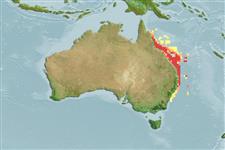Teleostei (teleosts) >
Eupercaria/misc (Various families in series Eupercaria) >
Nemipteridae (Threadfin breams, Whiptail breams)
Etymology: Nemipterus: Greek, nema, -atos = filament + Greek, pteron = wing, fin (Ref. 45335).
Eponymy: Edward Granville Theodore (1884–1950) was an Australian politician, nicknamed ‘Red Ted’, who served as Premier of Queensland (1919–1925). Ogilby honoured him “in recognition of the formation by him of a Department of Fisheries.” (Ref. 128868), visit book page.
More on author: Ogilby.
Environment: milieu / climate zone / depth range / distribution range
Ecology
Marine; demersal; non-migratory; depth range 19 - 410 m (Ref. 9785). Subtropical; 13°S - 36°S, 145°E - 158°E (Ref. 3810)
Western Pacific: restricted to eastern Australia from north Queensland to New South Wales.
Size / Weight / Age
Maturity: Lm ? range ? - ? cm
Max length : 24.0 cm SL male/unsexed; (Ref. 128312); common length : 18.0 cm SL male/unsexed; (Ref. 3810)
Dorsal spines (total): 10; Dorsal soft rays (total): 9; Anal spines: 3; Anal soft rays: 7. Suborbital spine absent. Preopercle with 3 transverse scale rows. Pectoral fins long, reaching to or almost to level of origin of anal fin. Pelvic fins very long, reaching to or beyond level of origin of anal fin. A line drawn up from posterior edge of suborbital reaching the dorsal profile at about or behind origin of dorsal fin. Upper lobe of caudal fin with dusky tip. Axillary scale present. Color: Upper body pinkish-mauve, pearly-white below. A purple stripe curving from lower edge of eye to upper lip. An indistinct bluish-grey spot on upper part of opercle.
Inhabits sandy or muddy bottoms.
Life cycle and mating behavior
Maturity | Reproduction | Spawning | Eggs | Fecundity | Larvae
Russell, B.C., 1990. FAO Species Catalogue. Vol. 12. Nemipterid fishes of the world. (Threadfin breams, whiptail breams, monocle breams, dwarf monocle breams, and coral breams). Family Nemipteridae. An annotated and illustrated catalogue of nemipterid species known to date. FAO Fish. Synop. 125(12):149p. Rome: FAO. (Ref. 3810)
IUCN Red List Status (Ref. 130435: Version 2024-1)
Threat to humans
Harmless
Human uses
Fisheries: minor commercial
Tools
Special reports
Download XML
Internet sources
Estimates based on models
Preferred temperature (Ref.
123201): 19.7 - 24.6, mean 21.5 °C (based on 16 cells).
Phylogenetic diversity index (Ref.
82804): PD
50 = 0.5000 [Uniqueness, from 0.5 = low to 2.0 = high].
Bayesian length-weight: a=0.01514 (0.00853 - 0.02685), b=2.96 (2.81 - 3.11), in cm total length, based on LWR estimates for this species & Genus-body shape (Ref.
93245).
Trophic level (Ref.
69278): 3.9 ±0.5 se; based on size and trophs of closest relatives
Resilience (Ref.
120179): High, minimum population doubling time less than 15 months (Preliminary K or Fecundity.).
Fishing Vulnerability (Ref.
59153): Low vulnerability (19 of 100).
